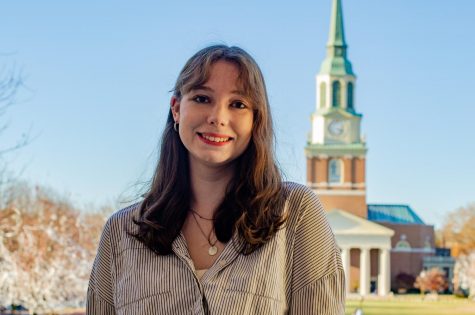Anthropology museum reopens to the public
With a new name, the anthropology museum staff hopes to enrich both students and members of the public
August 26, 2021
After 17 months of closure due to the COVID-19 pandemic, the Timothy S.Y. Lam Museum of Anthropology is reopening on Friday to the public under a new name, the Lam Museum of Anthropology.
The museum is also unveiling a new logo, which reflects the museum’s mission statement: to “[create] awareness of global cultures by collecting, protecting, managing, and exhibiting archaeological artifacts, ethnographic objects, and visual arts of past and present peoples and [provide] opportunities for intercultural learning,” per its website.
The new name honors Wake Forest alumnus Timothy S. Y. Lam (‘60), who donated a large collection of Tang Dynasty ceramics to the museum shortly before his passing in 2012. The name also honors his family, members of which carried on his generous legacy with the creation of a new academic excellence fund earlier this year. Lam’s collection is the largest and most comprehensive collection of ceramics from the Changsha Kilns in the United States.
During the temporary closure, Lam was accessible to students in person and online for socially-distanced internships, class projects and employment. There was also a Lunch & Learn series launched in February, in which participants pre-registered to discuss various anthropology-related topics with museum staff. However, students who have not gone to the museum since the onset of the pandemic will be met with many changes.
“The overall look of the [new museum] is quite different,” Sara Cromwell, the assistant director at Lam, said. “It is brighter with more clean lines [and] the galleries themselves are larger and more open. We [now] have a lot more behind-the-scenes space to work on projects or hold class meetings.”
There will be five new exhibits on display alongside the museum’s permanent “Stories of Humanity: Anthropology in North Carolina” installation. Of these, the central exhibit is ‘Culture at Stake’ (on display through August 2022), which was curated by students in an Introduction to Museum Studies course and focuses on unethical collecting.
“Culture at Stake” will feature objects from three of the Museum’s collections: the West Mexican shaft tomb ceramics, the Bura ceramics from Niger and the ethnographic objects from the Pacific islands.
“It traces the origins of these collections and discusses possible futures for these artifacts,” Cromwell said.
Also housed in the new museum will be three smaller exhibits curated by student interns, “Animal Origin: Tokens and Tools from Faunal Remains”, “Exchange in Melanesia” and “The Private Lives of Pots”. These exhibits focus on artifacts from around the world that are made using animal parts, objects connected to trade in the Pacific Islands, and the construction, use, and loss of cultural heritage caused by the archaeological looting of a recently donated collection of Ancient Middle Eastern pottery, respectively. “Animal Origin” will be on display through May, while the other two exhibits will be on display until Dec. 10.
Cromwell’s favorite exhibit is the annual bilingual Day of the Dead exhibit, “Life After Death: The Day of the Dead in Mexico”. New to the exhibit this year is a section on fantastical Mexican folk art sculptures. There is also an opportunity for visitors to leave memories or messages for their loved ones who have passed away.
“I look forward to setting up the ofrenda, or offering, each year and love the bright colors and skeleton imagery [in the exhibit],” Cromwell said. “I really admire the outlook that death is just another part of life and not something to be frightened of.”
The Lam Museum, and the family for which it is named, have given many members of the Wake Forest community a lasting appreciation of material culture and a greater understanding of anthropology. The in-depth research project opportunities offered to students serve as a launching pad to graduate school and future careers.
“Going forward, [we] envision using funds from the Lam family gift to enhance the possibilities for independent research,” Cromwell said. Advanced techniques like materials analysis, radiometric dating and digital image capture technology are all now on the table to better understand the Museum’s collections.”















